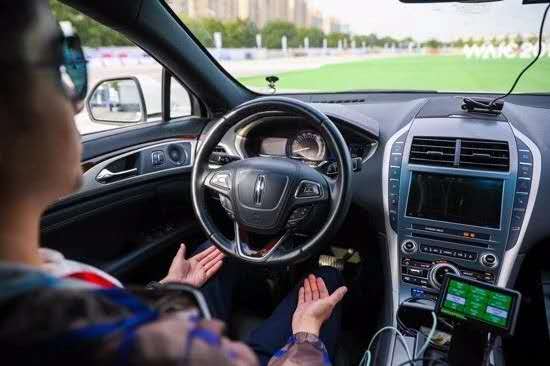Autonomous driving is disruptive innovation and the future that Didi must compete for.
Editor’s note: This article comes from “ Future Car Daily ” (WeChat public account ID: auto-time), author: Jiaoman Ting.

Didi Autonomous Driving Team unveiled at World Artificial Intelligence Conference 2019 Image source: Didi official
Author | Jiao Manting
Edit | Xu Yang
The independent Didi Autopilot department is close to the first blood transfusion.
On March 24th, according to The Information, the investment transaction led by Japan’s SoftBank Group in the Didi Autonomous Driving Division was close to completion, with a planned investment of USD 300 million. However, foreign media have not disclosed more details of the transaction, nor did they disclose the valuations of other investors and Didi’s autonomous driving department.
In this regard, Didi declined to comment.
The news of SoftBank’s investment in Didi has a long history. As early as July last year, people familiar with the matter said that Didi was negotiating with its largest shareholder, SoftBank and other potential investors, on the financing of its autonomous driving business. On August 5th, Didi Chuxing announced that its autonomous driving department was upgraded to an independent company, and Zhang Di, CTO of Didi Chuxing, also served as the CEO of the new autonomous driving company.
The self-driving business is regarded as one of the most important technologies in the future, but continuous investment is needed. In order not to drag down financial performance, Waymo was spun off from the Google X lab in 2016 to form a new driverless company. And in April 2019, on the eve of Uber’s listing, it also announced that it would divest itself of the autonomous driving department, and subsequently received a $ 1 billion investment.
Didi is facing a trade-off between profit and growth, and the divestiture of the self-driving business that burned money may be a new beginning for Didi to rewrite its growth story.
From “strategic focus” to business independence
In October 2016, Didi successively merged Kuai and Uber’s business in China. At that time, there was no rival in the field of ride-hailing. Cheng Wei also thought that more strategies should be planned for the future. For the first time, Didi has confirmed that it is developing a driverless business. At that time, Didi established the Autonomous Driving Research Institute.
Five months later, Didi ’s American Research Institute “camped in Silicon Valley” and started a talent battle. Former Waymo engineer Jia Zhaoyin officially joined Didi and became the head of cutting-edge technology. According to news, Didi also dug HR from Baidu Meiyan to set up a self-driving car team.
In 2017, Cheng Wei stated that autonomous driving “this matter is 10 times more important in my mind than local competition, and Didi will become the only unmanned company to survive outside Google.” In the field of autonomous driving, Didi frequently exposes muscles. In August of that year, Didi and Udacity held an autonomous driving test car challenge. In November, Didi opened a new park in Mountain View, Silicon Valley, mainly engaged in research and development of big data, smart transportation, and intelligent travel. In the same month, Didi established the map company “Ditu Technology”, and the legal representative is Dibo CTO Zhang Bo.
At the annual meeting in February 2018, Didi unmanned vehicles debuted. Didi employees saw a video of a driverless test. In the picture, CTO Zhang Bo sits on a modified Qoros car, and the unmanned car is in an autonomous driving state. In May, Didi’s US Research Institute was approved to test autonomous vehicles in California, becoming the 53rd company in California to obtain a test permit. In September, Didi obtained Beijing’s self-driving road test qualification and successfully obtained a road test license. .
In Cheng Wei ’s view, there are only one or two autonomous driving, and no third place. “At present, Google is the first, and I hope Didi can become another one that eventually survives.”
However, the two downwind car safety incidents pushed Didi to the edge of the cliff, attaching importance to safety, and maintaining growth has become Didi’s most important task. In addition, Didi lost about 10.9 billion yuan in 2018, and the plunge of Lyft and Uber, which went public in 2019, proves that the secondary market may not have to pay for the story of online ride-hailing.
Didi also needs to open source and reduce expenditures. At the company’s monthly full meeting held in February 2019, Cheng Wei announced that the company will be ready for the winter: in 2019, it will focus on the most important travel main business at present, “close and switch “Non-main business, layoffs after business reorganization, accounting for about 15% of the total staff, involving about 2,000 people, non-core businesses such as takeaways, wine travel have gradually stopped.
The autopilot that was once regarded as Didi’s future is also silent. When it returns to people’s vision again, Didi autonomous driving has reached the stage of “independent portal”.

Automatic driving display in the car Picture source: WeChat public account “Didi Chuxing”
Break through the dilemma, is 300 million US dollars enough?
Self-driving is a money-burning business, and even if Softbank’s $ 300 million landing, it will not be able to support it for too long.
Financial reports show that Google invests about $ 1 billion in Waymo each year, and Cruise, a subsidiary of General Motors, lost $ 1.512 billion in 2018. Since its launch in 2016, Uber’s driverless unit has burned money at an annual rate of about $ 240 million, and in the 18 months before August 2018, its driverless unit lost 125 million to 2 quarters a quarter. 100 million US dollars, accounting for 15% -30% of the company’s quarterly loss.
Softbank is also unable to continue to support Didi.
Didi unmanned is not the only thing Softbank has in mind. SoftBank likes to lay out the entire track. Previously, the SoftBank Vision Fund has invested in companies such as Cruise, Nuro and Uber. In addition, the failure of Uber’s listing last year and the collapse of Wework’s valuation have caused Softbank to face funding problems. SoftBank recently said that it will sell 41 billion US dollars (about 299.2 billion yuan) of assets to reduce its debt burden and reduce stocks. The repo provides funding.
The commercial value of driverlessness is still only in the imagination of the future. He Xiongsong, executive general manager of Chen Tao Capital, once said that the main problem of autonomous driving is that “over-optimistic technological progress and commercialization have fallen short of expectations. As a new technology, autonomous driving is still in the research and development and verification stage, and has not yet reached the The scale of application, especially in the field of Robo-taxi, is unlikely to be promoted on a large scale within five years. ”
But for Didi, autonomous driving is a future that must be fought for. The largest moat of Internet-linked cars is a huge number of drivers, but once unmanned driving is popular, this moat may collapse. For Didi, unmanned driving is a “destructive innovation” that can change the rules of the game. The more dangerous the weapon, the better it must be in your own hands.
In the field of autonomous driving, Didi does have its own advantages.
A senior executive in the field of autonomous driving told Future Auto Daily (ID: auto-time) that most companies have similar hardware configuration for self-driving cars. The key is algorithm. Didi’s advantage is massive road network data. Scheduling, but the advantages in terms of chips are still unclear. A high-definition map practitioner expressed optimism about Didi. He believes that “algorithms can pursue ‘bringing doctrine.'”
In December 2019, at the World Intelligent Connected Car Conference, Zhang Bo said that the entire autonomous driving industry has entered the second phase, and the second phase is to truly turn autonomous driving technology into products and products for everyone. life. Competition at this stage starts from competition between companiesIt becomes competition between alliances.
“There are four resources that are very important: one is the travel network; the other is to have core technology; the third is to support the automotive industry chain; the fourth is to have sufficient capital.”
Didi has more than 10 million drivers working on the platform every year, and these operating systems will bring value to unmanned driving. At the same time, Didi and 31 car companies and Tier1 established an open platform for automotive operations, the “torrent alliance”, and set up joint ventures with Toyota, Dongfeng Nissan, Volkswagen, Che Hejia and other car companies.
Now that capital is about to be in place, Didi Autopilot, which is no longer burdened with growth pressure, may speed up the pace of the road, and Didi itself can also go more securely on the road to growth.
